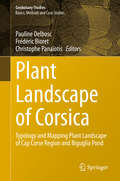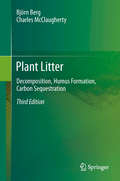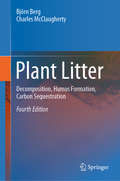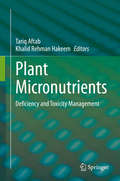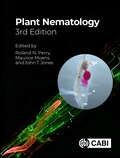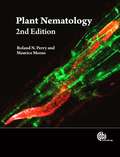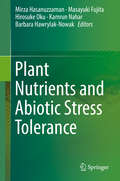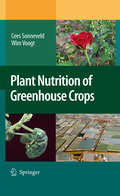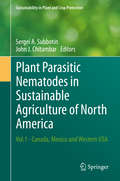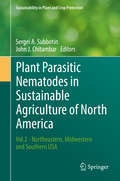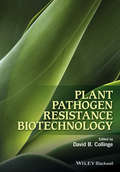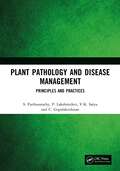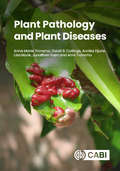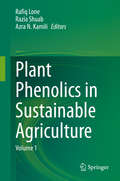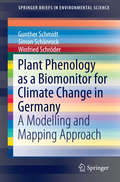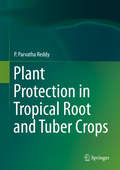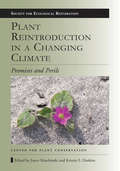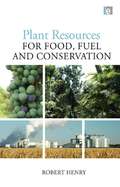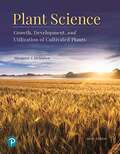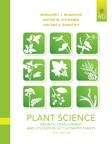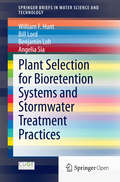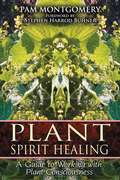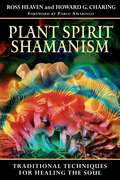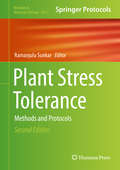- Table View
- List View
Plant Landscape of Corsica: Typology and Mapping Plant Landscape of Cap Corse Region and Biguglia Pond (Geobotany Studies)
by Pauline Delbosc Frédéric Bioret Christophe PanaïotisSince the 1970s and particularly the works of Tüxen (1978) and Géhu & Rivas-Martínez (1981), dynamico-catenal phytosociology has facilitated the integration of vegetation dynamics by more precisely describing the trajectories of vegetation series. A national habitat mapping program (CarHAB), launched by France’s Ministry of Ecology, aims to map the vegetation and vegetation series of metropolitan France at a scale of 1: 25,000 by 2025. In this context, Corsica has been selected as a pilot region, due to its unique characteristics regarding Mediterranean and alticole vegetation. This book describes in detail the vegetation series and geoseries (ecology, structure, dynamic trajectories, effects of anthropogenic factors on vegetation dynamics, catenal positioning in the landscape) of two Corsican sectors: Cap Corse and Biguglia pond. These two study sites were selected using two methods: • For Cap Corse, the typology and mapping are based on an inductive approach, which seeks to understand the dynamics of vegetation by drawing on the mature, substitutional, pioneering and anthropogenic associations likely to exist within a tessellar envelope. These various dynamic stages characterize “the vegetation series” (sigmetum or synassociation), the fundamental unit of symphytosociology (Géhu 2006; Biondi 2011). The aim of symphytosociology is, therefore, to define the vegetation series; in other words, it seeks to identify the repetitive combinations of syntaxa under homogeneous ecological conditions. • For Biguglia pond, the typology and mapping are based on a deductive approach, which combines (under SIG) the ecological descriptor maps with the vegetation mapping, in order to reveal the tesselas and the natural potential vegetation that underlies them. Thanks to the improvement of GIS techniques, this approach has been frequently used to characterize plant landscapes from vegetation to vegetation geoseries since the 2000s, with applications to the conservation management of natural and semi-natural environments.
Plant Life: The Entangled Politics of Afforestation
by Rosetta S. ElkinHow afforestation reveals the often-concealed politics between humans and plantsIn Plant Life, Rosetta S. Elkin explores the procedures of afforestation, the large-scale planting of trees in otherwise treeless environments, including grasslands, prairies, and drylands. Elkin reveals that planting a tree can either be one of the ultimate offerings to thriving on this planet, or one of the most extreme perversions of human agency over it. Using three supracontinental case studies—scientific forestry in the American prairies, colonial control in Africa&’s Sahelian grasslands, and Chinese efforts to control and administer territory—Elkin explores the political implications of plant life as a tool of environmentalism. By exposing the human tendency to fix or solve environmental matters by exploiting other organisms, this work exposes the relationship between human and plant life, revealing that afforestation is not an ecological act: rather, it is deliberately political and distressingly social. Plant Life ultimately reveals that afforestation cannot offset deforestation, an important distinction that sheds light on current environmental trends that suggest we can plant our way out of climate change. By radicalizing what conservation protects and by framing plants in their total aliveness, Elkin shows that there are many kinds of life—not just our own—to consider when advancing environmental policy.
Plant Litter
by Björn Berg Charles McclaughertySince the publication of the 2nd edition, there have been substantial developments in the field of litter decomposition. This fully revised and updated 3rd edition of Plant Litter reflects and discusses new findings and re-evaluates earlier ones in light of recent research and with regard to current areas of investigation. The availability of several long-term studies allows a more in-depth approach to decomposition patterns and to the later stages of decomposition, as well as to humus formation and accumulation. The latest information focuses on three fields: - the effects of manganese on decomposition and possibly on carbon sequestration, - new findings on decomposition dynamics, and - the new analytical technique using 13C-NMR.
Plant Litter: Decomposition, Humus Formation, Carbon Sequestration
by Björn Berg Charles McClaughertyThis book gives basic facts about litter decomposition studies, which are of guidance for scientists who start studies. Since the publication of the third edition, there has been quite a development not only in the field of litter decomposition but also in supporting branches of science, which are important for fruitful work on and understanding of decomposition of plant litter and sequestration of carbon. A consequence is that ‘old established truths’ are becoming outdated. New knowledge in the fields of phytochemistry and microbial ecology has given a new baseline for discussing the concepts ‘litter decomposition’ and ‘carbon sequestration’. We can also see a rich literature on litter decomposition studies using roots and wood as substrates. These have given new insights in factors that regulate the decomposition rate and as regards roots their contribution to sequestered carbon in humus. Additional facts on the role of temperature vs the litters’ chemical composition may in part change our view on effects of climate change. Further information on applications of the new analytical technique (13C-NMR) for determining organic-chemical compounds has allowed us to develop these parts. Focus is laid on needle litter of Scots pine as a model substrate as this species has been considerably more studied than other litter species. Also the boreal/northern temperate coniferous forest has in part been given this role. Still, new information may allow us to develop information about litter from further tree species.
Plant Micronutrients: Deficiency and Toxicity Management
by Khalid Rehman Hakeem Tariq AftabPlants require essential nutrients (macronutrients and micronutrients) for normal functioning. Sufficiency range is the levels of nutrients necessary to meet the plant’s needs for optimal growth. This range depends on individual plant species and the particular nutrient. Nutrient levels outside of a plant’s sufficiency range cause overall crop growth and health to decline, due either to deficiency or toxicity from over-accumulation. Apart from micronutrients (B, Cl, Mn, Fe, Zn, Cu and Mo), Aluminum (Al), cerium (Ce), cobalt (Co), iodine (I), lanthanum (La), sodium (Na), selenium (Se), silicon (Si), titanium (Ti), and vanadium (V) are emerging as novel biostimulants that may enhance crop productivity and nutritional quality. These beneficial elements are not "essential" but when supplied at low dosages, they augment plant growth, development, and yield by stimulating specific molecular, biochemical, and physiological pathways in responses to challenging environments.The book is the first reference volume that approaches plant micronutrient management with the latest biotechnological and omics tools. Expertly curated chapters highlight working solutions as well as open problems and future challenges in plant micronutrient deficiency or toxicity. We believe this book will introduce readers to state-of-the-art developments and research trends in this field.
Plant Nematology
by Maurice Moens Roland N. Perry John T. JonesPlant-parasitic nematodes are a major threat to crop production in all countries, and identification of nematodes and knowledge of their biology is of paramount importance. Providing a broad introduction to nematodes as plant parasites, this book begins by describing nematodes by genera, and then builds on this foundation to detail nematode biology and pest management, including resistance, and biological and chemical control. This 3rd edition is updated to address advances in our knowledge of plant-parasitic nematodes, particularly concerning the molecular aspects of host-parasite relationships, including the application of genomics to nematode biology. Changes in control and management strategies are also covered. The influence of climate change on plant-parasitic nematodes is addressed in a new chapter on ecology. Primarily aimed at students (MSc and PhD), this book is also invaluable for researchers and lecturers in nematology, plant pathology and parasitology, advisory and quarantine services, and crop protection scientists.
Plant Nematology
by Maurice Moens Roland N Perry* Fully updated to take account of the most recent research * Chapters are written by international experts and enhanced by extensive illustrations and focus boxes * Divided into three sections for ease of use
Plant Nutrients and Abiotic Stress Tolerance
by Masayuki Fujita Mirza Hasanuzzaman Hirosuke Oku Kamrun Nahar Barbara Hawrylak-NowakThis book discusses many aspects of plant-nutrient-induced abiotic stress tolerance. It consists of 22 informative chapters on the basic role of plant nutrients and the latest research advances in the field of plant nutrients in abiotic stress tolerance as well as their practical applications. Today, plant nutrients are not only considered as food for plants, but also as regulators of numerous physiological processes including stress tolerance. They also interact with a number of biological molecules and signaling cascades. Although research work and review articles on the role of plant nutrients in abiotic stress tolerance have been published in a range of journals, annual reviews and book chapters, to date there has been no comprehensive book on this topic. As such, this timely book is a valuable resource for a wide audience, including plant scientists, agronomists, soil scientists, botanists, molecular biologists and environmental scientists.
Plant Nutrition of Greenhouse Crops
by Wim Voogt Cees SonneveldGreenhouse cultivation is noted for its high uptake of minerals, consistent climatic conditions, exclusion of natural precipitation and control of salt accumulation. Acknowledging that plant nutrition in greenhouse cultivation differs in many essentials from field production, this volume details specific information about testing methods for soils and substrates in a greenhouse environment. It does so while offering a universally applicable analysis. This is based on the composition of the soil and substrate solutions, methods for the interpretation of tissue tests, and crop responses on salinity and water supply in relation to fertilizer application. Fertilizer additions, related to analytical data of soil and substrate samples, are presented for a wide range of vegetable and ornamental crops. The subject is especially apt now as substrate growing offers excellent possibilities for the optimal use of water and nutrients, as well as the potential for sustainable production methods for greenhouse crops.
Plant Parasitic Nematodes in Sustainable Agriculture of North America: Vol. 1 - Canada, Mexico And Western Usa (Sustainability In Plant And Crop Protection Ser.)
by Sergei A. Subbotin John J. ChitambarPlant-parasitic nematodes are recognized as one of the greatest threats to crop production throughout the world. Estimated annual crop losses of $8 billion in the United States and $78 billion worldwide are attributed to plant parasitic nematodes. Plant parasitic nematodes not only cause damage individually but form disease-complexes with other microorganisms thereby increasing crop loss. Nematode diseases of crops are difficult to control because of their insidious nature and lack of specific diagnostic symptoms which closely resemble those caused by other plant pathogens and abiotic diseases. Future developments of sustainable management systems for preventing major economical agricultural losses due to nematodes is focused on strategies that limit production costs, enhance crop yields, and protect the environment. This book presents a first compendium and overview for nematode problems and their management across North America. Each chapter provides essential information on the occurrence and distribution of plant parasitic nematodes, their major crop hosts, impact on crop production and sustainable management strategies for each region of the continent including, Canada, Mexico and all states of the USA. For each region, a thematic overview of changes in crop production affected by plant parasitic nematodes and their management strategies over time will provide invaluable information on the important role of plant parasitic nematodes in sustainable agriculture.
Plant Parasitic Nematodes in Sustainable Agriculture of North America: Vol. 1 - Canada, Mexico And Western Usa (Sustainability In Plant And Crop Protection Ser.)
by Sergei A. Subbotin John J. ChitambarPlant-parasitic nematodes are recognized as one of the greatest threats to crop production throughout the world. Estimated annual crop losses of $8 billion in the United States and $78 billion worldwide are attributed to plant parasitic nematodes. Plant parasitic nematodes not only cause damage individually but form disease-complexes with other microorganisms thereby increasing crop loss. Nematode diseases of crops are difficult to control because of their insidious nature and lack of specific diagnostic symptoms which closely resemble those caused by other plant pathogens and abiotic diseases. Future developments of sustainable management systems for preventing major economical agricultural losses due to nematodes is focused on strategies that limit production costs, enhance crop yields, and protect the environment. This book presents a first compendium and overview for nematode problems and their management across North America. Each chapter provides essential information on the occurrence and distribution of plant parasitic nematodes, their major crop hosts, impact on crop production and sustainable management strategies for each region of the continent including, Canada, Mexico and all states of the USA. For each region, a thematic overview of changes in crop production affected by plant parasitic nematodes and their management strategies over time will provide invaluable information on the important role of plant parasitic nematodes in sustainable agriculture.
Plant Pathogen Resistance Biotechnology
by David CollingePlant pathogens and diseases are among the most significant challenges to survival that plants face. Disease outbreaks caused by microbial or viral pathogens can decimate crop yields and have severe effects on global food supply. Understanding the molecular mechanisms underlying plant immune response and applying this understanding to develop biotechnological tools to enhance plant defense against pathogens has great potential for moderating the impact of plant disease outbreaks. Plant Pathogen Resistance Biotechnology's main focus is an in depth survey of the biological strategies being used to create transgenic disease resistant plants for sustainable plant resistance Plant Pathogen Resistance Biotechnology is divided into four sections. The first section covers biological mechanisms underpinning disease resistance in plants, while the second highlights case studies of important pathogen-crop groups and then considers why the application of important pathogen-crop groups, transgenic-based strategies designed to selectively target pathogens could benefit crop production. The third section provides information on the status of transgenic crops around the world, and finally the last part explores high-tech alternatives to genetic engineering for developing disease resistant traits in plants. Edited and authored by leaders in the field, Plant Pathogen Resistance Biotechnology will be an invaluable resource to those studying or researching plant biotechnology, plant pathology, plant biology, plant and crop genetics, in addition to crop science.
Plant Pathology and Disease Management: Principles and Practices
by S. Parthasarathy C. Gopalakrishnan P. Lakshmidevi V.K. SatyaThis book introduces the nature, causes and impact of plant diseases. It briefly describes the history of plant pathology as a scientific discipline and introduces the disease cycle as the key tool for understanding disease development and devising appropriate management strategies. It addresses the mechanisms of pathogenicity and immunity. It explores the biology of the interactions between plants and plant pathogens from the cellular level to the population level, with the chapter addressing epidemiology. The book then concerns the approaches we can take to alleviate the effects of plant pathogens. Print edition not for sale in India.
Plant Pathology and Plant Diseases
by Anne Marte Tronsmo David B Collinge Annika Djurle Lisa Munk Jonathan Yuen Arne TronsmoThis textbook provides a comprehensive introduction to all aspects of plant diseases, including pathogens, plant-pathogen interactions, their management, and future perspectives. Plant diseases limit potential crop production and are responsible for considerable losses in agriculture, horticulture and forestry. Our global food production systems are under increasing pressure from global trade, climate change and urbanization. If we could alleviate the losses due to plant diseases, we would be able to produce roughly 20% more food - enough to feed the predicted world population in 2050. Co-authored by a group of international teachers of plant pathology who have collaborated for many years, the book gives expert and seamless coverage. Plant Pathology and Plant Diseases: Addresses major advances in plant-pathogen interactions, classification of plant pathogens, and the methods of managing or controlling disease Is relevant for a global audience; it covers many examples of diseases with an impact worldwide but with an emphasis on disease of particular importance in a temperate context Features over 400 striking figures and colour photographs It is suitable for graduate students and advanced undergraduates studying plant pathology, biology, agriculture and horticulture.
Plant Phenolics in Sustainable Agriculture: Volume 1
by Rafiq Lone Razia Shuab Azra N. KamiliThis book presents the latest research on plant phenolics, offering readers a detailed, yet comprehensive account of their role in sustainable agriculture. It covers a diverse range of topics, including extraction processes; the role of plant phenolics in growth and development; plant physiology; post-harvesting technologies; food preservation; environmental, biotic and abiotic stress; as well as nutrition and health. Further the book provides readers with an up-to-date review of this dynamic field and sets the direction for future research. Based on the authors’ extensive experience and written in an engaging style, this highly readable book will appeal to scholars from various disciplines. Bringing together work from leading international researchers, it is also a valuable reference resource for academics, researchers, students and teachers wanting to gain insights into the role of plant phenolics in sustainable agriculture.
Plant Phenology as a Biomonitor for Climate Change in Germany
by Winfried Schröder Gunther Schmidt Simon SchönrockThe investigations refer to the development of plant phenology since the 1960s in Germany. Spatiotemporal trends were assessed by means of regression kriging. It could be shown that there already is a distinct shift of phenological onset towards the beginning of the year of up to two weeks. In future, a shift of up to one month was calculated till 2080. Moreover, a prolongation of the vegetation period of up to three weeks was found. The findings are relevant for the development of mitigation measures to prevent from environmental, agricultural and economic issues due to climate change.
Plant Protection in Tropical Root and Tuber Crops
by P. Parvatha ReddyThis book is a compilation of information on insect/mite/vertebrate pests and fungal/bacterial/viral/mycoplasma/nematode diseases of tropical root and tuber crops such as cassava, sweet potato, yams, taro, Amorphophallus, yam bean and tannia. The book highlights the distribution, symptoms and damage, biology, survival and spread of each pest and describes management methods. It also sheds light on different eco-friendly pest management strategies including physical, cultural, chemical, biological, host resistance and integrated methods. The book is written in a lucid style using easy-to-understand language and offers adoptable recommendations involving eco-friendly control measures. It serves as a useful reference source for policy makers, research and extension workers, practicing farmers and students. The material can also be used for teaching post graduate courses in state agricultural universities.
Plant Reintroduction in a Changing Climate: Promises and Perils (Science Practice Ecological Restoration)
by Kristin E. Haskins Joyce MaschinskiThis volume presents a comprehensive review of reintroduction projects and practices, the circumstances of their successes or failures, lessons learned, and the potential role for reintroductions in preserving species threatened by climate change. Contributors examine current plant reintroduction practices, from selecting appropriate source material and recipient sites to assessing population demography. The findings culminate in a set of Best Reintroduction Practice Guidelines, included in an appendix to the book. These guidelines cover stages from planning and implementation to long-term monitoring, and offer not only recommended actions but also checklists of questions to consider that are applicable to projects around the world. Plant Reintroduction in a Changing Climate is a comprehensive and accessible reference for practitioners to use in planning and executing rare plant reintroductions.
Plant Resources for Food, Fuel and Conservation
by Robert James HenryAgriculture and food production have a large footprint on the landscape globally and compete for space with land for nature conservation. This book explores the competition between the food needs of a growing human population and the conservation of biodiversity as intensified by the emerging use of crops for energy production. As concern about the impact of greenhouse gas emissions on climate grows and oil prices increase, energy production from agricultural crops has become a significant industry. At the same time, growth in food demand due to population growth has been accelerated by growing affluence associated with economic growth in major developing countries increasing per capita consumption. Consumers are concerned that the price of food will continue to increase sharply as a result of this competition but a loss of biodiversity may be another major outcome. Drawing on his expertise in plant conservation genetics, the author provides a balanced appraisal of the potential for developing new or improved crops for food or bioenergy production in the context of climate change, while at the same time protecting biodiversity.
Plant Science: Growth, Development, And Utilization Of Cultivated Plants
by Margaret McMahonThorough foundation in plant cultivation suitable for learners of all levels Plant Science: Growth, Development, and Utilization of Cultivated Plants is the premier resource on the basic principles of ecological relationships and their impact on cultivation. Comprehensive and engaging, Plant Science addresses all relevant topics, from the fundamentals of botany to complex cultivation strategies and sustainability concerns. The breadth of topics covered by this text make it ideal for most plant science courses, including the combined agronomy-horticulture curricula that universities are increasingly adopting. The 6th edition has been updated with a wealth of new information, images, and features, and now draws a stronger connection between natural, agricultural, and horticultural ecosystems.
Plant Science: Growth, Development, and Utilization of Cultivated Plants
by Margaret E. Mcmahon Anton M. Kofranek Vincent E. RubatzkyPlant Science: Growth, Development, and Utilization of Cultivated Plants, Fifth Edition, is an outstanding resource for anyone with an interest in how plants are grown and utilized for maintaining and adding enjoyment to human life. The text starts with the fundamentals of botany, plant physiology, and environmental factors affecting plant growth, while later sections integrate those topics into strategies of producing plants for human use as food, fiber, and recreation. The concept of sustainability and sustainable methods of growing plants runs throughout the text. Whether you are familiar or unfamiliar with plant science, this book will give you a firm understanding of concepts and terminology related to the growing of plants.
Plant Selection for Bioretention Systems and Stormwater Treatment Practices
by William F. Hunt Bill Lord Benjamin Loh Angelia SiaAs cities develop, more land is converted into impervious surfaces, which do not allow water to infiltrate. Careful urban planning is needed to ensure that the hydrologic cycle and water quality of the catchment areas are not affected. There are techniques that can attenuate peak flow during rain events and reduce the amount of metals, nutrients, and bacteria that enter the urban water cycle. This brief gives a short introduction on bioretention systems and documents the effectiveness of some 36 plant species in removing water pollutants. A summary on the maintenance requirements is also presented.
Plant Spirit Healing: A Guide to Working with Plant Consciousness
by Stephen Harrod Buhner Pam MontgomeryA hands-on approach to working with the healing powers of plant spirits • Explores the scientific basis underlying the practices of indigenous healers and shamans • Illuminates the matrix where plant intelligence and human intelligence join • Reveals that partnering with plants is an evolutionary imperative Indigenous healers and shamans have known since antiquity that plants possess a spirit essence that can communicate through light, sound, and vibration. Now scientific studies are verifying this understanding. Plant Spirit Healing reveals the power of plant spirits to join with human intelligence to bring about profound healing. These spirits take us beyond mere symptomatic treatment to aligning us with the vast web of nature. Plants are more than their chemical constituents. They are intelligent beings that have the capacity to raise consciousness to a level where true healing can take place.In this book, herbalist Pam Montgomery offers an understanding of the origins of disease and the therapeutic use of plant spirits to bring balance and healing. She offers a process engaging heart, soul, and spirit that she calls the triple spiral path. In our modern existence, we are increasingly challenged with broken hearts, souls in exile, and malnourished spirits. By working through the heart, we connect with the soul and gain access to spirit. She explains that the evolution of plants has always preceded their animal counterparts and that plant spirits offer a guide to our spiritual evolution--a stage of growth imperative not only for the healing of humans but also the healing of the earth.
Plant Spirit Shamanism: Traditional Techniques for Healing the Soul
by Pablo Amaringo Ross Heaven Howard G. CharingAn in-depth look at the role of plant spirits in shamanic rituals from around the world • Shows how shamans heal using their knowledge of plant spirits as well as the plant’s “medical properties” • Explores the core methods of plant shamanism--soul retrieval, spirit extraction, and sin eating--and includes techniques for connecting with plant spirits • Includes extensive field interviews with master shamans of all traditions In Plant Spirit Shamanism, Ross Heaven and Howard G. Charing explore the use of one of the major allies of shamans for healing, seeing, dreaming, and empowerment--plant spirits. After observing great similarities in the use of plants among shamans throughout the world, they discovered the reason behind these similarities: Rather than dealing with the “medical properties” of the plants or specific healing techniques, shamans commune with the spirits of the plants themselves. From their years of in-depth shamanic work in the Amazon, Haiti, and Europe, including extensive field interviews with master shamans, Heaven and Charing present the core methods of plant shamanism used in healing rituals the world over: soul retrieval, spirit extraction, sin eating, and the Amazonian tradition of pusanga (love medicine). They explain the techniques shamans use to establish connections to plant spirits and provide practical exercises as well as a directory of traditional Amazonian and Caribbean healing plants and their common North American equivalents so readers can ex-plore the world of plant spirits and make allies of their own.
Plant Stress Tolerance
by Ramanjulu SunkarA number of abiotic factors such as drought, salinity, extreme temperatures, low or high light intensity, and deficiency or toxic levels of nutrients have huge impacts on crop productivity, and a furthering of our understanding of the molecular, biochemical, and physiological basis of stress tolerance has been widely recognized as critical. In Plant Stress Tolerance: Methods and Protocols, expert researchers cover the most important widely-used techniques, including cutting-edge strategies, in a manner that ensures effective results. Beginning with reviews on dehydration, salinity, and cold tolerance as well as on oxidative stress, the volume then continues with methods involving topics such as describing the identification of stress-regulated genes, proteins, and microRNAs using diverse approaches, measurement of osmotic adjustment, proline levels, enzymes involved in proline metabolism, and sugars as well as determination of ROS levels, lipid peroxidation, ion leakage, and the enzymes involved in ROS detoxification. Written in the highly successful Methods in Molecular Biology(tm) series format, chapters include introductions to their respective subjects, lists of the necessary materials and reagents, step-by-step, readily reproducible laboratory protocols, and tips on troubleshooting and avoiding known pitfalls. Comprehensive and up-to-date, Plant Stress Tolerance: Methods and Protocols provides a wide range of easy-to-follow protocols catering to the needs of plant physiologists, biochemists, and molecular biologists interested in probing this vital area of study.
